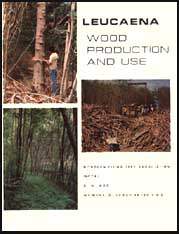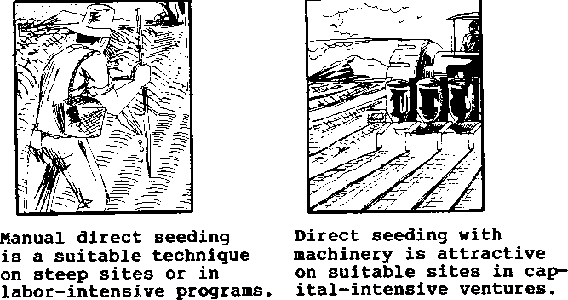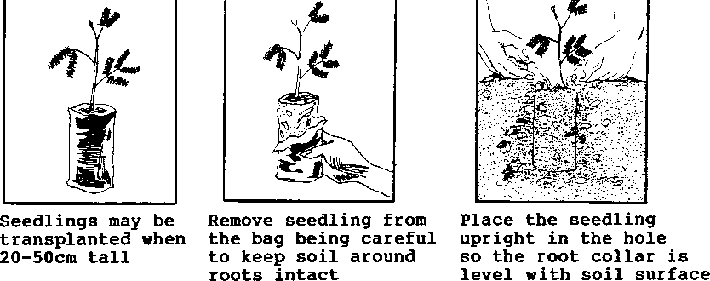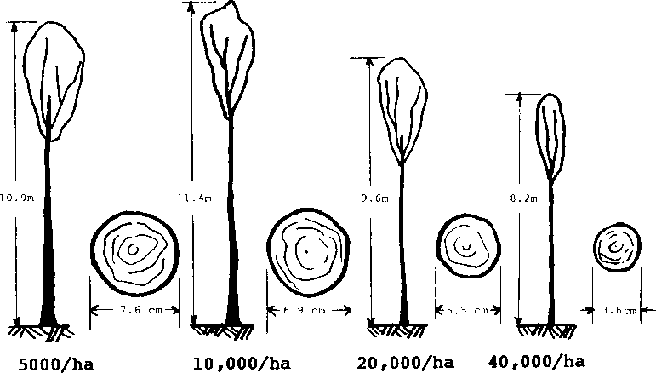The season of planting can be critical in the establishment of leucaena, particularly in the sub-humid and dry tropics. Severe dry seasons will kill newly planted seedlings. Planting at the onset of the monsoon season may be essential for establishment in many areas. Direct-seeded plantings are even more sensitive to early rains than are transplanted seedlings.
A useful guide for early rainy season plantings might be to plant leucaena at the same time corn, rice or similar crops would be planted. If rainfall is fairly well distributed through the year, season of planting is perhaps of little importance, although seedling growth is greatest in months of high incident light and temperature.
5-2 SITE PREPARATION
Site preparation methods vary depending on intended use, type of planting materials, topography and vegetation of the area to be planted. Site preparation is very important to the success of establishment, as weed growth can easily outgrow young seedlings. In general, the site should be cleared of vegetation and burned, plowed, or herbicide-killed before planting.
In areas where they are economical to use, herbicides provide the best insurance towards successful leucaena establishment. A number of currently available herbicides are suitable for several types of weed problems, yet there is no entirely satisfactory herbicide for every soil and climatic situation.
It is essential to prepare a field in which all perennial weeds have been killed or severely damaged for pre-plant herbicides to be effective. In areas where grassy perennials like Imperata exist, foliar application of glyphosate (Roundup 2 kg ate. /ha) 1 month prior to site preparation can save much time and followup post-plant weedings.
Some herbicides such as trifluralin (0.5 kg a.i./ha)* and alachlor (3 kg a.i./ha) require incorporation into the soil by tilling or rotovating the top 10 cm. Others may be applied after direct seeding the leucaena. These include 2,4-D amine (4 kg a.e./ha) DCPA (8-10 kg a.i./ha) and Oryzalin (3kg a.i./ha). For most of these herbicides to be effective, the soil should be moist at sowing, or should receive rain or irrigation within a few days of sowing.
Pre-plant herbicides generally control weeds for only a limited period of 6-8 weeks. This may be adequate to give leucaena a good start, although further control by post-emergence sprays or cultivation may be required. Where seedlings are transplanted, the herbicide rates given above may be increased by 25% for better weed control.
Figure 5-1 Total weed elimination, either mechanical, chemical, or manual is advised for leucaena establishment.
Cultivated lands. The best stand establishment is obtained using land preparation similar to that used for row crops or forage plantings. This is especially true for direct seeding where weed competition during the establishment period can lead to failure. Tillage can be done more roughly for plantations by seedlings, although thorough tillage on cultivated lands generally results in fewer weed problems after planting.
Grasslands Most leucaena plantings are likely to involve marginal lands covered with coarse. perennial grasses. These grasses must be suppressed by cultivation, heavy grazing, burning, herbicide, or some combination of these methods. A common practice is to burn the area at the end of the dry season, or, if possible, just after the beginning of the rainy season when new shoots have begun to emerge. Rows may be prepared by cultivation early in the rainy season before planting using plows or manual hole digging.
Brushland or secondary forest. Cutting and burning, tractor clearing or herbicide killing can be practiced to prepare brush or forest lands for transplanting. Land preparation on this type of land is nearly always more expensive than land preparation on other types of land unless there is a market for the trees being removed.
5-3 DIRECT SEEDING
Direct seeding is an increasingly favored approach to the establishment of leucaena wood plantations. The success of direct seeding hinges on timing, land preparation, and weed management. The primary advantage of direct seeding over transplanting is the elimination of nursery operations, resulting in substantial cost savings. The major constraint is the need for intensive weed management during the early months after establishment. Although a greater level of management is implied in direct seeding, effective establishment has been achieved by planting leucaena seeds in the same manner as row crops (notably corn) with which small farmers are most familiar.
Figure 5-2 Direct seeding of leucaena is an establishment method that can be either capital or labor intensive.
Site preparation should be as thorough as possible, to suppress or eliminate perennial grasses. Burning alone is not adequate in most grasslands, but may be effective as part of a weed control program utilizing repeated burnings or a combination of burning and herbicide or mechanical controls. Chemical weed control using herbicides such as glyphosate are often most effective, but are usually expensive and require knowledge of the methods and precautions necessary for effective and safe control. Scarified seed should be sown at 2-3 times the rate finally desired and should not be deeply covered with soil, but planted at a depth of 1-2 cm. Weed growth must be monitored carefully, and not allowed to overtop the seedlings. Seedlings should be thinned in 2-3 months to one per hill at the desired spacing.
5-4 TRANSPLANTING
Transplanting techniques may require less field preparation than direct seeding, but require more attention to placement of seedlings and watering during the early establishment period.
Seedlings grown in dibble tubes are best placed into holes made with a tool which makes holes similar in shape and size to the tube itself (Figure 4-1). Special tools similar to planting bars used in forestry practice are made for this purpose, although tapered rods or sticks can also be used. Care must be taken to provide a planting hole which is large enough to accommodate the tap root without bending or breaking and yet small enough to leave as little potential air space as possible. Containers should be completely removed from seedlings before transplanting. Soil should be firmly packed around the seedling after it is placed in the planting hole.
Figure 5-3 Transplanting of bagged leucaena seedlings.
5-5 FERTILIZATION
Pre-plant fertilization is recommended for leucaena in many tropical soils, due to their poor nutrient status. Soils allocated to tree plantations have often been impoverished by agriculture or coarse grasses and have become poor in phosphorous and calcium. Fertilization practices for leucaena are largely indicated by soil pH, which is often low on these degraded sites. Leucaena has a strong positive response to phosphorous, and treatments of 100-200 kg/ha of single superphosphate are wisely applied to soils recovered from grass or agricultural use.
Where soils are between pH 6 and 8, nutrients are usually adequate, but may be deficient. Basic soils with pH above 7.5 may be deficient in nutrients such as iron and zinc, and these can be used to supplement phosphate.
In acid soils with pH of less than 6.0, low fertility is common and calcium deficiency may be a major limiting factor to leucaena. Dolomite at 200 kg/ha can be added to supply sufficient Ca and Mg. Rock phosphate could replace superphosphate, at 200 kg/ha plus 100 kg/ha of calcium sulfate.
In highly acid and aluminous soils, special methods usually are needed to establish leucaena, but they may be worth the trouble. Holes can be prepared by removing soil, treating with appropriate fertilizers, dolomite or lime, replacing the soil and planting. A less costly alternative is to plant nitrogen-fixing tree species which are more tolerant of acid soils. Examples of such species would be Albizia falcataria or Acacia auriculiformis.
5-6 SPACING
Diameter and height development of leucaena is influenced by per hectare populations (Figure 5.3). Generally, diameter growth is affected more by high populations than height growth. Thus, spacing is an effective management tool which when considered in conjunction with rotation age can be used by the manager to produce material of suitable diameter and length for many different purposes.
Figure 5-4 Effects of population density on height and diameter development of 4-year-old leucaena trees. Values are averages of plots in Hawaii spacing study.
The trick to using spacing as a management tool is to keep in mind three major determinants:
- The use intended for the product. If small diameter material is required, closer spacing is indicated. Larger diameter products require more growing space per tree.
- Site quality. On weedy or infertile sites, it may be necessary to opt for closer spacings to lessen the time of crown closure. Arid lands may require wide spacings, lest competition for water become a limiting factor.
- The age at which a particular spacing will inhibit growth. Different spacings give optimum per-hectare volumes at particular ages. The closer the spacing, the less time it takes to complete one rotation.
Maximum total wood yield of leucaena, without regard to wood quality is achieved by high population densities of between 10,000 20,000/ha. For fuelwood plantations, where high labor intensity is acceptable, these high populations lead to small diameter trees of somewhat shorter stature, but with more total wood per ha than wider spacings.
Postwood, props, and household fuelwood are best grown at close spacings (10,000 - 40,000/ha) and harvested on a 1-3 year cycle. Larger diameter materials (poles, charcoal stock) require spacings of 5000-10,000/ha with a rotation age of 3-5 years. Large diameter products (pulpwood, timber for sawing) are perhaps best produced at 5000-10,000/ha and later thinned to lower densities, leaving superior stems. Rotation age can be extended to 6 or more years.
5-7 THINNING AND PRUNING
Thinning involves the removal of offtype and immature trees to reduce plant populations, thereby accelerating incremental diameter growth and improving the form of remaining trees. This practice is less important in leucaena than with other tree species since leucaena is a self-pollinating plant with little or no true differences from plant to plant. Observed differences will be primarily due to micro environment, and to competition at high population densities.
Thinning is normally uneconomical in capital-intensive projects, especially when population densities are high. For laborintensive operations, it may be an economic method of providing small firewood, green manure and fodder, or postwood. Thinning can be practiced in pulpwood or sawtimber plantations to improve stem form, e.g., establishment at 1 x 1m with thinning to 1 x 2m or 2 x 2m during the second or third year.
The removal by pruning of dead or dying branches is usually unnecessary in leucaena plantations. The species is highly selfpruning at normal densities. Dead branches fall early, or are easily knocked from the tree for gathering as fuelwood. Some live branch pruning for this purpose may be condoned.



